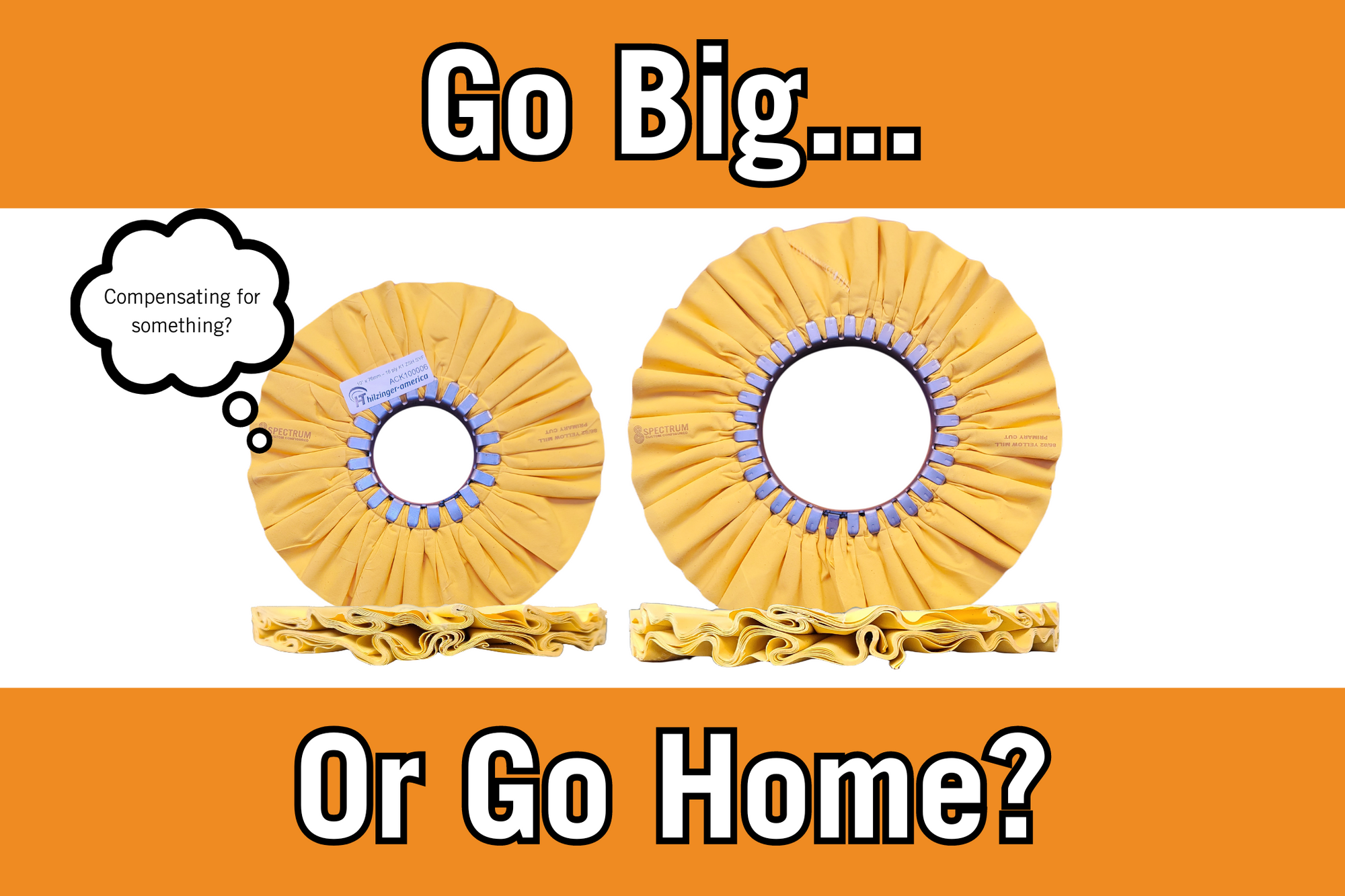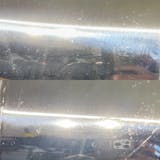Both 10" x 3" and 12" x 5" buffing wheels have their advantages, but for efficiency's sake, the Spectrum crew prefer 12" diameter buffs to help them save time. Several factors help 12" buffing wheels produce a faster cut: surface speed, material volume, and surface area.
What difference does it make?
The most obvious answer is larger diameter means longer reach - and in contrast, smaller diameter means a better fit for tight spaces. But what other advantages and disadvantages do 12" buffs have compared to 10" buffs?
- Surface Speed
- At a given RPM a 12" buffing wheel is moving the same speed at the arbor/spindle as a 10" buff, but at the edge (where the work is done) it is moving 20% faster (it has a higher surface speed).
- Abrasive compound is being applied 20% faster.
- Centripetal force pulls harder on the fabric of the buffing wheel, causing it to pull tighter, resulting in a firmer face and more aggressive cutting action than at a lower surface speed.
- Note that this causes more strain on the clinch ring, but that the larger diameter ring also has more teeth in the material to hold it in place. Regardless, manufacturers typically rate larger diameter buffs for lower maximum RPMs particularly because 12" buffs tend to contain more material (the additional mass creates additional strain).
- As a result it generates more friction and heat, which can be advantageous on cooler days.

- Surface Area
- A 12" buffing wheel has a 20% greater circumference, and although perhaps not wider, has more surface area for polishing compound to be applied to, resulting in more buffing per compound application (and potentially, time saved).
- Material Volume
- All else equal, a 12" x 5" buff (#2, 16 ply) has almost 17% more material than a 10" x 3" buff (#2, 16 ply). This means a longer lifespan as well as more surface area (via pleating) for compound to adhere at the edge of the buff, and as a result a potentially faster cut.
- How much material a buffing wheel can contain is primarily limited to the diameter of the clinch ring (width helps, but only a little).
- As a result, standard 10" buffing wheels are made in a #2 pack, while heavy duty 10" buffing wheels are made in a #4 pack. Our Hilzinger grey and yellow 10" x 3" buffs are made in an especially dense #5 pack (25% more material than #2 pack).
- In contrast, our 12" x 5" grey and yellow buffs are made in #6 and #8 packs; the #8 pack has almost 67% more material than a 10" x 3", # 2 pack.
- Strip Length vs. Clinch Ring Circumference
- Although a 12" x 5" buff can hold more material and its additional surface speed helps to make the edge feel firmer, a 10" buff can often feel firmer than an otherwise equivalent 12" buff. This is because the ratio of how long each ply is compared to the clinch ring is larger:
- Each ply on a 10", #2 buff is 4x the length of the clinch ring (stretched out)
- Each ply on our 10", #5 buffs is 5x the length of the clinch ring
- Each ply on a 12", #2 buff is only 2.8x the length of the clinch ring
- Each ply on our 12", #8 buff is only 4x the length of the clinch ring (like a 10", #2 buff)
- In other words, the material on the 3" ring is compressed to a greater degree, and will generally feel firmer
- To achieve as an equal ply/clinch ring ratio with our 12" x 5" buffs, we would need to produce a #13 pack buff, which would have 108% more material than a standard 10" buff.
- My suspicion is although a material has a certain compression factor (how much force it takes to compress it), the more material you try to compress, the more that force is multiplied (i.e., it's more difficult to make a #13 pack 12" x 5" than a #5 pack 10" x 3").
- The strip width of each ply is the same for both buffs (12" - 5" and 10" - 3" both = 7" wide strips of material.

Note, however, that there can be diminishing returns on excessive firmness: as the firmness of the face of the buff increases, less of the buffing wheel is in contact with the surface at one time. More pressure is applied but to a smaller area. This mostly a problem for especially hard treatments.

This effect can make aggressive dip treatments that are advantageous on larger format buffs excessively hard on smaller, more tightly compressed buffs. Generally, an especially hard buff is preferred to efficiently pre-polish hard, flat surfaces but is less flexible when it comes to curved workpieces.
- Mass
- Due to the higher volume of steel and buffing material, a 12" buff also tends to weigh more than a 10" buff. This can create some additional strain on the operator and on the motor of handheld polishing tools (which are not designed to handle buffing wheels as it is).
- This can lead to tools overheating more frequently... but due to the higher surface speeds and generally more efficient cutting action of 12" buffs, less pressure is required by the operator, resulting in less drag and strain on the machine (than by a slower 10" buff being pushed into the workpiece) and compensating reduced fatigue on the operator (let the machine do the work).
- Mounting
- Although a minor issue, 5" centers mean different safety flanges, which is a small extra expense.


